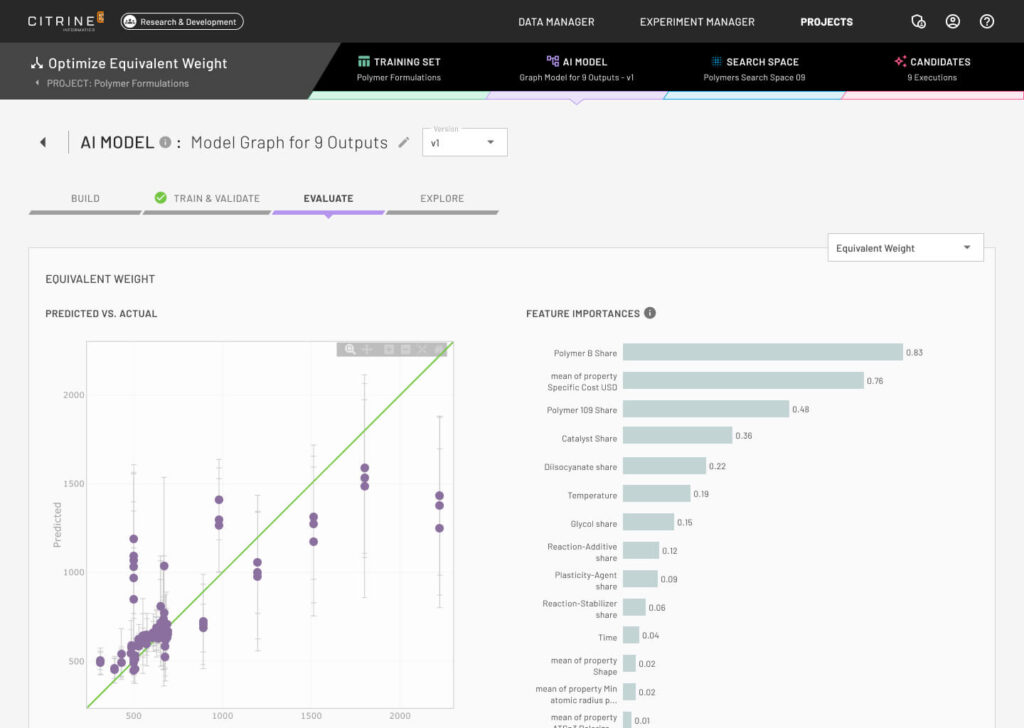Author: James Peerless, PhD – Senior AI Product Manager
The Data Is Not Enough
In the Citrine Platform, each data point is a real material – carefully crafted and precisely measured by experts. While other AI applications may have millions or billions of data points to work with, our users are often starting with fewer than one hundred. So how can we apply AI to such small data?
The good news is that we’re not blindly matching patterns. Chemistry and materials science equip us with rules and data enhancements that allow us to be much more predictive than a naive learning tool. Our platform leverages this automatically turning information-rich descriptors like molecular structures into a batch of properties; learning from a full process history when predicting performance. But the most impactful way to enhance our ability to learn from your data comes from you, the user.
“The way that you design models through the materials history really reflects the way that experiments are truly done, and I think that that is pretty game changing.”
— Vijay Narasimhan, Director R&D Collaborations, EMD Electronics

The product experts that use the Citrine Platform know their processes better than anyone else. But efficiently getting that information from domain experts into the AI model easily is key.
You don’t need to be a machine learning expert to structure your data and configure your experimental search space in the Citrine Platform. And when it comes to model building, we give our users a great default, and then empower them to choose what information the model learns from and how, from picking inputs and outputs to adding custom-calculated properties. If you know that the stoichiometric ratio of A to B is critical to performance of your product, you can (and should) put that calculation right in the model.
“AI felt very far away. [But] with Citrine you don’t even need any programming skills.”
— Florian, Application Engineer, Gebrüder Dorfner GmbH & Co.

And if you’re ever unsure of how to make a change, just ask our Catalyst Model Assistant to do it for you. A cornerstone of the Citrine Platform is that it is fundamentally a tool for scientists and engineers, not data scientists and machine learning engineers.
It’s a Two-Way Street
Although our users are still the experts on their process, AI models “think” fundamentally differently. What they may lack in common sense, they make up for in their ability to simultaneously operate in hundreds of dimensions and consider a massive array of possibilities. The real magic of AI comes from merging these two ways of thinking.
“I like to talk about convergent intelligence, where it is the conversation between the machine and the human that is bringing insight.”
—Vijay Narasimhan, Director R&D Collaborations, EMD Electronics
So far we’ve talked about an AI Model learning from you, but don’t you want to learn from your model? Scientists are a diverse group, but one thing they have in common is a deep curiosity. The Citrine Platform gives our users the tools to learn from their models just as much as the models learn from them.
These include:
- Graphically represented models, where you can immediately see which inputs feed into which outputs
- Ranking the most important inputs to your key performance properties
- Our Model Explorer tool where Product experts can play out “what if” scenarios to see how the model reacts to swapping out an ingredient, or turning a dial from 85 to 90
“We understand our own laboratory more than before. It’s fun to work in this way.”
—Oliver, Technical Application Lead

Our new Feature Impact plots contain detailed information on how each value of an input “pushes” the prediction in one way or another. Seeing this information across your existing data helps you understand your process better and make decisions. “It seems unlikely that elevating the temperature above 250°C will improve tensile strength, but adding more additive A might.”

The Shoulders of Giants
Models become knowledge repositories. You have contributed an insight or two, and maybe a colleague has as well, but the model keeps it all.
Now you have a prediction engine containing the knowledge of your best experts that can continue to generate insight and accelerate development long after you’ve moved to the next project. Along with other assets, like search spaces, and your experimental data itself, the models you’ve built become part of an invaluable storehouse of not just information, but insights you and your team can leverage for continuous improvement.
Learn More – Know More
By interacting with AI, researchers can do so much more than generate predictions. At Citrine, we’ve seen countless examples of veteran product developers being inspired by an outcome they didn’t expect, or motivated to search in a new direction they hadn’t considered.
“It’s led us into new creative directions from the experimental side.”
—Vijay Narasimhan, Director R&D Collaborations, EMD Electronics
The Citrine Platform bridges the gap between expert domain knowledge and AI’s analytical capabilities, facilitating a dynamic learning environment where users inform model development, and models provide new insights into development processes. With intuitive tools like Feature Impact plots and Model Explorer, users can understand and, in turn, influence their AI models, turning them into valuable repositories of collective expertise. By embodying a symbiotic approach to AI-assisted materials development, Citrine not only accelerates innovation but also deepens our understanding of the intricate relationships at the core of product performance.
If you’re interested in learning more, I, along with our excellent Director of Data Science & Data Engineering Scott Isaacson, will be giving a webinar on this topic December 18th, 11 AM EST. Join us to hear more about how the conversation between experts and AI leads to success in product development. You’ll see more of the platform in action and can get your questions answered in the Q&A session.
